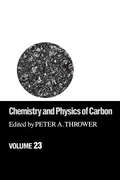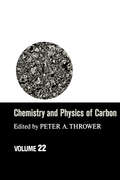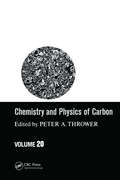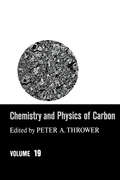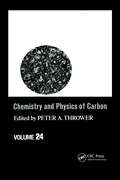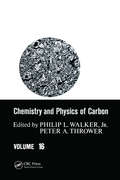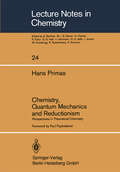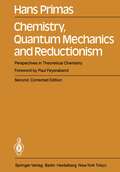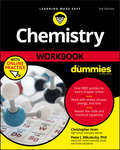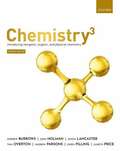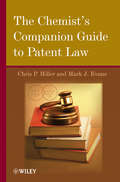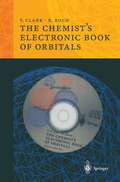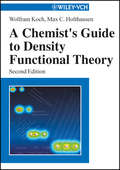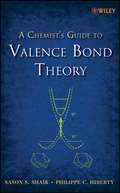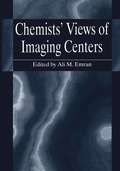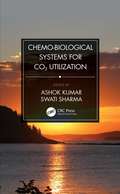- Table View
- List View
Chemistry & Physics of Carbon: Volume 23
by Peter A. ThrowerThis book presents authoritative, interdisciplinary coverage of contemporary topics in the field of carbon chemistry and physics and clearly shows the diversity and universality of carbon research. It is useful for readers working in the general area of carbon adsorbents.
Chemistry & Physics of Carbon: Volume 22
by Peter A. ThrowerThis book provides insights into the mechanisms of primary carbonization and reviews the graphitization of various carbon materials under applied pressures. It discusses the changes in the thermal-mechanical properties of carbon/carbon composites due to stress effects.
Chemistry & Physics of Carbon: Volume 22
by Peter A. ThrowerThis book provides insights into the mechanisms of primary carbonization and reviews the graphitization of various carbon materials under applied pressures. It discusses the changes in the thermal-mechanical properties of carbon/carbon composites due to stress effects.
Chemistry & Physics of Carbon: Volume 20 (Chemistry And Physics Of Carbon Ser.)
by Peter A. ThrowerThis book provides a fundamental understanding of the basis of the theoretical treatment of electronic properties in graphite. It illustrates the wide range of topics of interest to researchers on carbon materials and stimulates further understanding of some of the phenomena involved.
Chemistry & Physics of Carbon: Volume 19
by Peter A. ThrowerThis volume reviews the evidence for some elements substituting directly for carbon atoms in the graphite lattice. It is an invaluable resource to all carbon researchers and to those who involved with graphite materials, and serves to provoke research.
Chemistry & Physics of Carbon: Volume 19
by Peter A. ThrowerThis volume reviews the evidence for some elements substituting directly for carbon atoms in the graphite lattice. It is an invaluable resource to all carbon researchers and to those who involved with graphite materials, and serves to provoke research.
Chemistry & Physics of Carbon: Volume 24
by Peter A. ThrowerThis 24th volume continues in the tradition of its predecessors, presenting authoritative, interdisciplinary coverage of contemporary topics in the field of carbon chemistry and physics. With contributions by leading international experts, this volume: describes pitch polymerization kinetics during mesophase formation and the constitution of coexisting phases in mesophase pitch during heat treatment; elucidates the mechanism of mesophase formation and pitch polymerization kinetics after mesophase formation; examines the importance of physical, solid-state, electro- and analytical chemistry in the study of carbon surfaces; discusses the theoretical background for the thermal conductivity of diamonds, single crystal diamonds and chemically-vapour-deposited diamond films; and explains the chemistry involved in the commercial fabrication and use of needle coke.
Chemistry & Physics of Carbon: Volume 20 (Chemistry And Physics Of Carbon Ser.)
by Peter A. ThrowerThis book provides a fundamental understanding of the basis of the theoretical treatment of electronic properties in graphite. It illustrates the wide range of topics of interest to researchers on carbon materials and stimulates further understanding of some of the phenomena involved.
Chemistry & Physics of Carbon: Volume 16
by Philip L. WalkerThis book provides insights into the mechanisms of primary carbonization, discusses changes in the thermal-mechanical properties of carbon/carbon composites due to stress effects. It describes factors that result in the acceleration of the graphitization process.
Chemistry & Physics of Carbon: Volume 16
by Philip L. WalkerThis book provides insights into the mechanisms of primary carbonization, discusses changes in the thermal-mechanical properties of carbon/carbon composites due to stress effects. It describes factors that result in the acceleration of the graphitization process.
Chemistry & Physics of Carbon: Volume 24
This 24th volume continues in the tradition of its predecessors, presenting authoritative, interdisciplinary coverage of contemporary topics in the field of carbon chemistry and physics. With contributions by leading international experts, this volume: describes pitch polymerization kinetics during mesophase formation and the constitution of coexisting phases in mesophase pitch during heat treatment; elucidates the mechanism of mesophase formation and pitch polymerization kinetics after mesophase formation; examines the importance of physical, solid-state, electro- and analytical chemistry in the study of carbon surfaces; discusses the theoretical background for the thermal conductivity of diamonds, single crystal diamonds and chemically-vapour-deposited diamond films; and explains the chemistry involved in the commercial fabrication and use of needle coke.
Chemistry, Quantum Mechanics and Reductionism: Perspectives in Theoretical Chemistry (Lecture Notes in Chemistry #24)
by H. PrimasThe purpose of this book is to provide a deeper insight into the modern theories of molecular matter. It incorporates the most important developments which have taken place during the last decades and reflects the modern trend to abstraction. At the present state of the art we have acquired a fairly good knowledge of "how to. compute" small molecules us ing the methods of quantum chemistry. Yet, in spite of many statements to the contrary and many superficial discussions, the theoretical basis of chemistry and biology is not safely in our hands. It is all but impossible to summarize the modern developments of the theory of matter in nontechnical language. But I hope that I can give some feeling for the problems, the intellectual excitements and the wor ries of some theoreticians. I know very well that such an enterprise is a dangerous adventure and that one says that a clever scientist should take care of his reputation by barricading himself behind the safe wall of his speciality. This volume is not meant to be a textbook; in many respects it has complementary goals. For good and bad reasons, most textbooks ignore the historical and philosophical aspects and go ahead on the basis of crude simplifications; many even lie like the devil and do not shrink from naive indoctrination. Some sections of this book can be read as commentaries on our standard texts, they are intended to stir the waters with controversy.
Chemistry Questions For CCEA GCSE
by Alyn G. McFarlandProvides banks of questions to address the requirements of the revised CCEA GCSE Chemistry specification and covers both the full Chemistry course and the Chemistry component of Double Award Science. Questions are entirely new, not from past papers and suitable for use as classroom material, for use in homework and to assist with revision. The author, Alyn McFarland, is a highly reputable author and will be well known to teachers in Northern Ireland. To encourage the students' work answers will not be printed in the rear of the book. A full set of answers, including the process where appropriate, is available via this link: http://colourpointeducational.com/media/content/ChemistryGCSEAnswers.pdf This is one of three similar books that will also cover GCSE Biology and Physics.
Chemistry Workbook For Dummies
by Chris Hren Peter J. MikuleckyTake the confusion out of chemistry with hundreds of practice problems Chemistry Workbook For Dummies is your ultimate companion for introductory chemistry at the high school or college level. Packed with hundreds of practice problems, this workbook gives you the practice you need to internalize the essential concepts that form the foundations of chemistry. From matter and molecules to moles and measurements, these problems cover the full spectrum of topics you'll see in class—and each section includes key concept review and full explanations for every problem to quickly get you on the right track. This new third edition includes access to an online test bank, where you'll find bonus chapter quizzes to help you test your understanding and pinpoint areas in need of review. Whether you're preparing for an exam or seeking a start-to-finish study aid, this workbook is your ticket to acing basic chemistry. Chemistry problems can look intimidating; it's a whole new language, with different rules, new symbols, and complex concepts. The good news is that practice makes perfect, and this book provides plenty of it—with easy-to-understand coaching every step of the way. Delve deep into the parts of the periodic table Get comfortable with units, scientific notation, and chemical equations Work with states, phases, energy, and charges Master nomenclature, acids, bases, titrations, redox reactions, and more Understanding introductory chemistry is critical for your success in all science classes to follow; keeping up with the material now makes life much easier down the education road. Chemistry Workbook For Dummies gives you the practice you need to succeed!
Chemistry Workbook For Dummies
by Peter J. Mikulecky Chris HrenTake the confusion out of chemistry with hundreds of practice problems Chemistry Workbook For Dummies is your ultimate companion for introductory chemistry at the high school or college level. Packed with hundreds of practice problems, this workbook gives you the practice you need to internalize the essential concepts that form the foundations of chemistry. From matter and molecules to moles and measurements, these problems cover the full spectrum of topics you'll see in class—and each section includes key concept review and full explanations for every problem to quickly get you on the right track. This new third edition includes access to an online test bank, where you'll find bonus chapter quizzes to help you test your understanding and pinpoint areas in need of review. Whether you're preparing for an exam or seeking a start-to-finish study aid, this workbook is your ticket to acing basic chemistry. Chemistry problems can look intimidating; it's a whole new language, with different rules, new symbols, and complex concepts. The good news is that practice makes perfect, and this book provides plenty of it—with easy-to-understand coaching every step of the way. Delve deep into the parts of the periodic table Get comfortable with units, scientific notation, and chemical equations Work with states, phases, energy, and charges Master nomenclature, acids, bases, titrations, redox reactions, and more Understanding introductory chemistry is critical for your success in all science classes to follow; keeping up with the material now makes life much easier down the education road. Chemistry Workbook For Dummies gives you the practice you need to succeed!
Chemistry3: Introducing Inorganic, Organic And Physical Chemistry (PDF)
by Andrew Burrows John Holman Simon Lancaster Tina Overton Andrew Parsons Gwen Pilling Gareth PriceChemistry is widely considered to be the central science: it encompasses concepts on which all other branches of science are developed. Yet, for many students entering university, gaining a firm grounding in chemistry is a real challenge. Chemistry³ responds to this challenge, providing students with a full understanding of the fundamental principles of chemistry on which to build later studies. Uniquely amongst the introductory chemistry texts currently available, Chemistry³'s author team brings together experts in each of organic, inorganic, and physical chemistry with specialists in chemistry education to provide balanced coverage of the fundamentals of chemistry in a way that students both enjoy and understand. The result is a text that builds on what students know already from school and tackles their misunderstandings and misconceptions, thereby providing a seamless transition from school to undergraduate study. Written with unrivalled clarity, students are encouraged to engage with the text and appreciate the central role that chemistry plays in our lives through the unique use of real-world context and photographs. Chemistry³ tackles head-on two issues pervading chemistry education: students' mathematical skills, and their ability to see the subject as a single, unified discipline. Instead of avoiding the maths, Chemistry³ provides structured support, in the form of careful explanations, reminders of key mathematical concepts, step-by-step calculations in worked examples, and a Maths Toolkit, to help students get to grips with the essential mathematical element of chemistry. Frequent cross-references highlight the connections between each strand of chemistry and explain the relationship between the topics, so students can develop an understanding of the subject as a whole. Digital formats and resources Chemistry³ is available for students and institutions to purchase in a variety of formats, and is supported by online resources. The e-book offers a mobile experience and convenient access along with functionality tools, navigation features, and links that offer extra learning support: www.oxfordtextbooks.co.uk/ebooks The e-book also features interactive animations of molecular structures, screencasts in which authors talk step-by-step through selected examples and key reaction mechanisms, and self-assessment activities for each chapter. The accompanying online resources will also include, for students: · Chapter 1 as an open-access PDF; · Chapter summaries and key equations to download, to support revision; · Worked solutions to the questions in the book. The following online resources are also provided for lecturers: · Test bank of ready-made assessments for each chapter with which to test your students · Problem-solving workshop activities for each chapter for you to use in class · Case-studies showing how instructors are successfully using Chemistry3 in digital learning environments and to support innovative teaching practices · Figures and tables from the book
Chemistry for Cambridge International AS & A Level
by Roger NorrisThis workbook with digital access is the perfect companion for the coursebook. The resource reinforces learning, promotes application of theory and helps students practise the essential skills of handling data, evaluating information and problem solving. The workbook includes a range of formative exercises, mapped directly onto the coursebook. For each chapter, a range of exercises builds on the topics and concepts that have been introduced. It includes exam command terms throughout to help familiarise students with their appropriate use. Questions include a skills focus that require students to draw graphs or provide workings.
The Chemist's Companion Guide to Patent Law
by Chris P. Miller Mark J. EvansWritten by an individual with experience as both a chemist and a patent attorney, The Chemist's Companion Guide to Patent Law covers everything the student or working chemist needs to know about patentability, explaining important concepts of patent law (such as novelty, non-obviousness, and freedom-to-operate) in easy-to-understand terms. Through abundant examples from case law as well as real-world situations with which a researcher might be faced, this book provides readers with a better understanding of how to put that knowledge into practice.
The Chemist's Companion Guide to Patent Law
by Chris P. Miller Mark J. EvansWritten by an individual with experience as both a chemist and a patent attorney, The Chemist's Companion Guide to Patent Law covers everything the student or working chemist needs to know about patentability, explaining important concepts of patent law (such as novelty, non-obviousness, and freedom-to-operate) in easy-to-understand terms. Through abundant examples from case law as well as real-world situations with which a researcher might be faced, this book provides readers with a better understanding of how to put that knowledge into practice.
The Chemist’s Electronic Book of Orbitals
by Timothy Clark Rainer B. KochThis CD-ROM and textbook package introduces chemistry students to the world of molecular orbitals using 3D and VRML representations. An overview of the basic chemistry and physics needed enables readers to move quickly onto the CD. The CD-ROM itself contains an extended interactive textbook and a broad selection of classical organic compounds and inorganic complex ligands complete with their orbitals. Moreover, interactive demonstrations allow students to alter relevant parameters and watch the change in the orbitals'characteristics or take a walk through this fascinating 3D world.
A Chemist's Guide to Density Functional Theory
by Wolfram Koch Max C. Holthausen"Chemists familiar with conventional quantum mechanics will applaud and benefit greatly from this particularly instructive, thorough and clearly written exposition of density functional theory: its basis, concepts, terms, implementation, and performance in diverse applications. Users of DFT for structure, energy, and molecular property computations, as well as reaction mechanism studies, are guided to the optimum choices of the most effective methods. Well done!" Paul von Rague Schleyer "A conspicuous hole in the computational chemist's library is nicely filled by this book, which provides a wide-ranging and pragmatic view of the subject.[...It] should justifiably become the favorite text on the subject for practioneers who aim to use DFT to solve chemical problems." J. F. Stanton, J. Am. Chem. Soc. "The authors' aim is to guide the chemist through basic theoretical and related technical aspects of DFT at an easy-to-understand theoretical level. They succeed admirably." P. C. H. Mitchell, Appl. Organomet. Chem. "The authors have done an excellent service to the chemical community. [...] A Chemist's Guide to Density Functional Theory is exactly what the title suggests. It should be an invaluable source of insight and knowledge for many chemists using DFT approaches to solve chemical problems." M. Kaupp, Angew. Chem.
A Chemist's Guide to Valence Bond Theory
by Sason S. Shaik Philippe C. HibertyThis reference on current VB theory and applications presents a practical system that can be applied to a variety of chemical problems in a uniform manner. After explaining basic VB theory, it discusses VB applications to bonding problems, aromaticity and antiaromaticity, the dioxygen molecule, polyradicals, excited states, organic reactions, inorganic/organometallic reactions, photochemical reactions, and catalytic reactions. With a guide for performing VB calculations, exercises and answers, and numerous solved problems, this is the premier reference for practitioners and upper-level students.
Chemists’ Views of Imaging Centers
by Ali M. EmranTo continue the support for the growing trend of chemistry involvement in nuclear medicine, the Division of Nuclear Chemistry and Technology (DNCT) of the American Chemical Society (ACS) planned for a symposium to cover this aspect. This was expressed in arequest to me, as a member of the Program Committee, to organize a symposium on topics related to nuclear and radiochemistry applications to nuclear medicine. Realizing the growing interest in imaging, specially with positron emitting radioisotopes, I invited several colleagues to study with me the idea of imaging centers and the involvement of chemists in their structure and function. The formulated Organizing Committee supported this idea which evolved in proposing an extended international symposium to be held in conjunction with the 206th ACS National meeting in Chicago, Illinois, U. S. A. on August 22-27, 1993. The following are the members of the Organizing Committee: Jorge R. Barrio, Ph. D. Thomas E. Boothe, Ph. D. J. Robert Dahl, Ph. D. Robert F. Dannals, Ph. D. Bruce R. Erdal, Ph. D. Mark M. Goodman, Ph. D. George W. Kabalka, Ph. D. James F. Lamb, Ph. D. Ronald G. Manning, Ph. D. Henry C. Padgett, Ph. D. Roy S. Tilbury, Ph. D. Steven W. Yates, Ph. D. and Ali M. Emran, Ph. D.
Chemo-Biological Systems for CO2 Utilization
by Ashok Kumar Swati SharmaChemo-Biological Systems for CO2 Utilization describes the most recent advanced tools and techniques for carbon dioxide capture and its utilization. It discusses and compares the advantages of different systems and aids researchers and industrialists in understanding energy generation in the form of biofuels, bioelectricity, or biogas using chemicals; nanomaterials; and microbial, enzymatic, and chemo-enzymatic-integrated systems. It describes the importance and utilization of CO2 in living systems, and provides an overview of the various fundamental methods, policies, and techniques involved in CO2 conversion. Emphasis is placed on the production of value-added products using CO2, including biomethanol, industrial carbonates, and liquid or gaseous fuels. Features: Explains the correlations between microbial, biological, and chemical products and their roles in the conversion of CO2 into usable energy and related products. Being suitable for a broad audience, it addresses fundamental treatment methods for reusing environmental waste materials. Aids in decision-making and policy planning for environmental professionals. The information provided throughout this book will help researchers and professionals working in various industries to better understand the conversion of CO2 into energy-based products. Chemo-Biological Systems for CO2 Utilization also serves as a useful guide to seek alternative methods for clean energy and mitigating global climate change.
